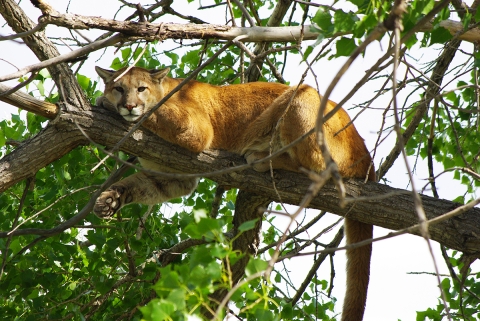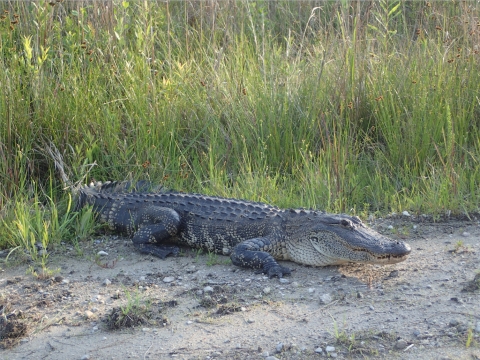America’s public lands, including national wildlife refuges and parks, offer tremendous opportunities to explore and enjoy the great outdoors, most from sunrise to sunset every day. Hike, fish, observe and photograph wildlife! These places offer unique opportunities to see wildlife, but it's always important to remember your personal safety.
Safety should always be the number one concern when enjoying nature, whether it’s in the form of making sure cycling, biking or climbing equipment is in good working order or taking the possibility of severe weather into account before departing for the outdoors.
Here are a few tips to follow while exploring wild places:
- Be aware of your surroundings and what animals may be present that could pose a threat in that environment.
- Never feed wild animals, even squirrels or chipmunks. Keep them wild and don’t risk attracting predators.
- If you are camping, keep the area clean: wash all cooking and eating utensils after use and store left over food in airtight containers.
- Report any wildlife attacks to 911.
As for safety when it comes to some of the larger predators, we collected a few best practices around exploring in areas that include bears, mountain lions and alligators.
Bears
In the U.S., brown bears are found in Alaska, Wyoming, Montana, Idaho and a potentially small population in Washington. The American black bear is found in at least 40 states in the U.S.
“The opportunity to view a bear in the wild is an unforgettable experience. With some basic wildlife safety precautions, people can absolutely enjoy recreating and observing wildlife in refuges and parks,” -- says Lisa Hupp, Park Ranger, Kodiak National Wildlife Refuge, U.S. Fish and Wildlife Service.
If you encounter a bear:
- Be bear aware and look for signs of recent bear traffic. Leave when you see crushed plants, scat or fresh tracks. Avoid surprising bears when you are out hiking by making noise: clap your hands, sing and talk. Travel in groups and make extra noise if you are in a brushy or loud area.
- If you see a bear, stand still and stay calm. Assess how the bear is behaving. If it hasn't noticed you, quietly move away. Bears primarily use their noses to get information about the world, but they also have reasonably good eyesight and hearing.
- If you encounter young bears, back away in the direction you came. If your trail goes close by them, find another way around. The mother is likely nearby and you don’t want to get between her and her cubs.
- If a bear is aware of you, talk calmly and face the bear. If the bear does not approach, back away slowly until you are at a safe distance to leave the area.
- Do not allow them to obtain human food or associate humans with a food reward – even fish! A bear that knows it can find food around humans is no longer wild. Store your food and garbage properly.
- Never run from a bear. Bears can sprint at up to 40 mph – and, like dogs, will chase animals that run away. If you are approached or charged by a bear, stand your ground and use your bear deterrent (i.e. spray). Most charges by bears are defensive, not predatory.
- In the very rare event you get knocked down by a defensive bear, roll on your stomach and “play dead.” The bear will leave when it perceives you are not a threat. If the attack is prolonged or predatory, fight back.
- If attacked by a black bear, do not play dead. Try to escape to a place such as a car or building. If escape is not possible, try to fight back using any object available.
Mountain Lions
Mountain lions tend to be elusive and typically avoid people. They are primarily found in 14 western states, as well as in Florida, where a subspecies called the Florida panther is protected as endangered under the Endangered Species Act. Below are safety tips for traveling through known mountain lion areas.
- Do not hike, bike or jog alone. Go in groups with adults supervising children. Avoid hiking or jogging when mountain lions are most active—dawn, dusk and at night.
- Keep children close to you. Animals seem especially drawn to children; keep children within sight at all times.
- Do not approach a mountain lion. Most mountain lions will try to avoid confrontation. Give them a way to escape.
- Do not run from a lion. Running may stimulate a mountain lion's instinct to chase. Do not crouch down or bend over. A human standing does not resemble a mountain lion's natural prey.
- Do all you can to appear larger. Raise your arms. If wearing a jacket, take it off and wave it around. Pick up small children. Wave arms slowly, speak firmly in a loud voice, throw rocks or other objects.Try to remain standing and face the attacking animal. Fight back if attacked.
Alligators
The American alligator is a living prehistoric relic, having survived on earth for 200 million years. While the population is secure, some related reptiles – crocodiles and caimans – are still in trouble. For this reason, the U.S. Fish and Wildlife Service continues to protect the alligator under the Endangered Species Act as “threatened due to similarity of appearance”. Alligators live in lakes, rivers and wetland areas year-round, along the Atlantic and Gulf of Mexico coasts from Florida and the Carolinas to Texas, as well as parts of the inland states of Oklahoma and Arkansas.
- Alligators can be inconspicuous, spending much of their time floating in water just below the surface. Although alligators should be considered dangerous, they are inherently afraid of humans, and typically pose no serious threat if left alone.
- Give alligators their space and never feed them. When fed, alligators can overcome their natural wariness and learn to associate people with food. Dispose of fish scraps in garbage cans. Do not throw them into the water.
- Alligator bites are most likely to occur in or around water. However, they can lunge at prey if within a few feet of the shoreline. Be aware of the possible presence of alligators when in or near fresh or brackish water.
- Keep your distance and do not approach alligators for photographs or a “better look”.
- Never allow children or pets to play, swim or exercise in bodies of water these reptiles may call home. Be vigilant when you are near shorelines, especially between dusk and dawn when alligators are most active.
- If an alligator bites you, the best thing you can do is fight back, making as much noise and commotion as possible. Hitting or kicking the alligator, or poking it in its eyes may cause it to release its grip.
- Never remove an alligator from its natural habitat or accept one as a pet. It is illegal and dangerous to do so. Handling even small alligators can result in injury.
Visitor safety and wildlife conservation are our top priorities. Enjoy your adventure!
-- Vanessa Kauffman, Spokeswoman for U.S. Fish and Wildlife Service
This story is part of our Open Spaces blog.





